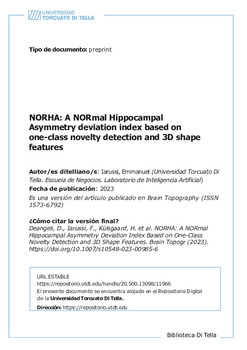Mostrar el registro sencillo del ítem
NORHA: A NORmal Hippocampal Asymmetry Deviation Index Based on One-Class Novelty Detection and 3D Shape Features
| dc.rights.license | http://rightsstatements.org/page/InC/1.0/?language=es | es_AR |
| dc.contributor.author | Iarussi, Emmanuel | es_AR |
| dc.contributor.author | Deangeli, Duilio | es_AR |
| dc.contributor.author | Külsgaard, Hernán | es_AR |
| dc.contributor.author | Iarussi, Francisco | es_AR |
| dc.contributor.author | Braggio, Delfina | es_AR |
| dc.contributor.author | Princich, Juan Pablo | es_AR |
| dc.contributor.author | Bendersky, Mariana | es_AR |
| dc.contributor.author | Larrabide, Ignacio | es_AR |
| dc.contributor.author | Orlando, José Ignacio | es_AR |
| dc.date.accessioned | 2023-08-02T10:43:56Z | |
| dc.date.available | 2023-08-02T10:43:56Z | |
| dc.date.issued | 2023 | |
| dc.identifier.uri | https://repositorio.utdt.edu/handle/20.500.13098/11966 | |
| dc.identifier.uri | https://doi.org/10.1007/s10548-023-00985-6 | |
| dc.description.abstract | Radiologists routinely analyze hippocampal asymmetries in magnetic resonance (MR) images as a biomarker for neurodegenerative conditions like epilepsy and Alzheimer’s Disease. However, current clinical tools rely on either subjective evaluations, basic volume measurements, or disease-specific models that fail to capture more complex differences in normal shape. In this paper, we overcome these limitations by introducing NORHA, a novel NORmal Hippocampal Asymmetry deviation index that uses machine learning novelty detection to objectively quantify it from MR scans. NORHA is based on a One-Class Support Vector Machine model learned from a set of morphological features extracted from automatically segmented hippocampi of healthy subjects. Hence, in test time, the model automatically measures how far a new unseen sample falls with respect to the feature space of normal individuals. This avoids biases produced by standard classification models, which require being trained using diseased cases and therefore learning to characterize changes produced only by the ones. We evaluated our new index in multiple clinical use cases using public and private MRI datasets comprising control individuals and subjects with different levels of dementia or epilepsy. The index reported high values for subjects with unilateral atrophies and remained low for controls or individuals with mild or severe symmetric bilateral changes. It also showed high AUC values for discriminating individuals with hippocampal sclerosis, further emphasizing its ability to characterize unilateral abnormalities. Finally, a positive correlation between NORHA and the functional cognitive test CDR-SB was observed, highlighting its promising application as a biomarker for dementia. | es_AR |
| dc.description.sponsorship | La versión final de este artículo fue publicada el 29 de junio de 2023 en Brain Topography (Springer). Se encuentra accesible desde Biblioteca Di Tella a través de Primo | es_AR |
| dc.format.extent | 17 p. | es_AR |
| dc.format.medium | application/pdf | es_AR |
| dc.language | eng | es_AR |
| dc.publisher | Brain Topography | es_AR |
| dc.publisher | Springer | es_AR |
| dc.relation.ispartof | Este artículo se encuentra publicado desde el 29 de junio de 2023 en Brain Topography (Springer) | es_AR |
| dc.relation.isversionof | NORHA: A NORmal Hippocampal Asymmetry Deviation Index Based on One-Class Novelty Detection and 3D Shape Features. Brain Topogr (2023). https://doi.org/10.1007/s10548-023-00985-6 | |
| dc.rights | info:eu-repo/semantics/restrictedAccess | es_AR |
| dc.subject | Alzheimer Disease | es_AR |
| dc.subject | Brain | es_AR |
| dc.subject | diagnostic imaging | es_AR |
| dc.title | NORHA: A NORmal Hippocampal Asymmetry Deviation Index Based on One-Class Novelty Detection and 3D Shape Features | es_AR |
| dc.type | info:eu-repo/semantics/article | es_AR |
| dc.subject.keyword | Novelty detection | es_AR |
| dc.subject.keyword | Machine learning | es_AR |
| dc.subject.keyword | Hippocampus | es_AR |
| dc.subject.keyword | Normal asymmetries | es_AR |
| dc.type.version | info:eu-repo/semantics/publishedVersion | es_AR |

